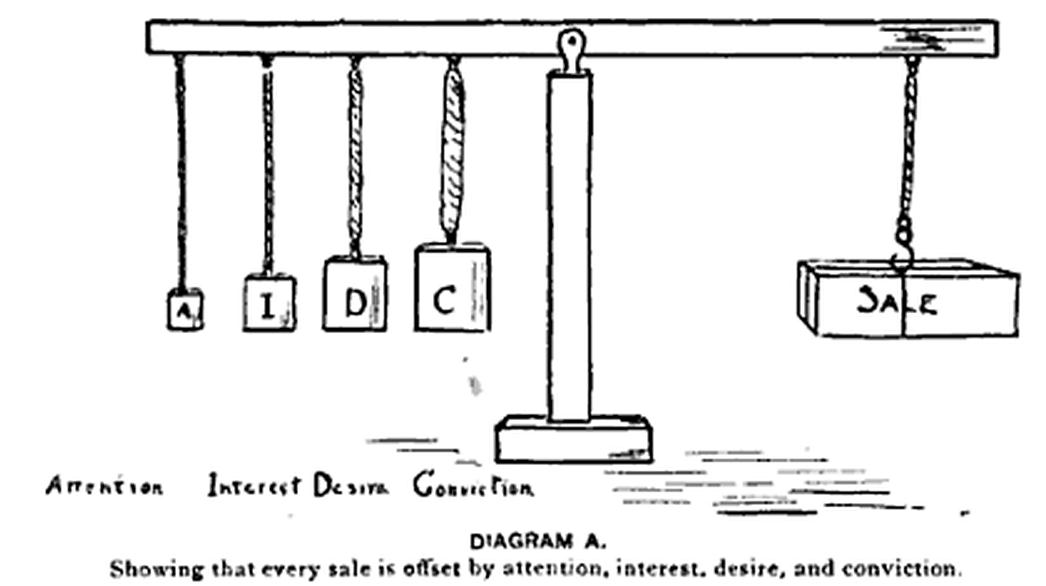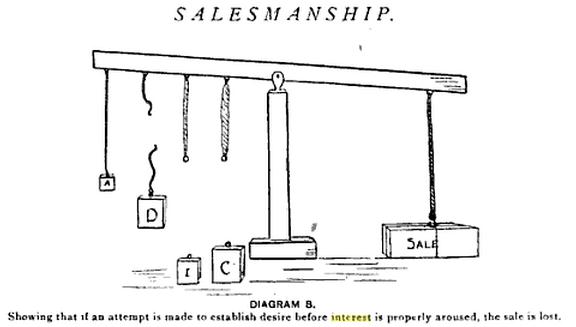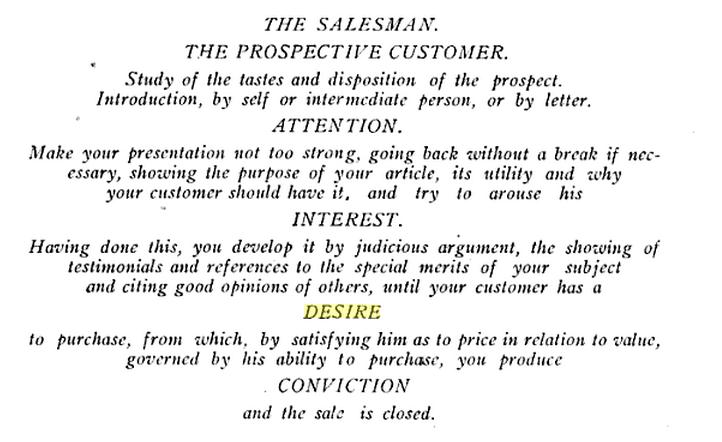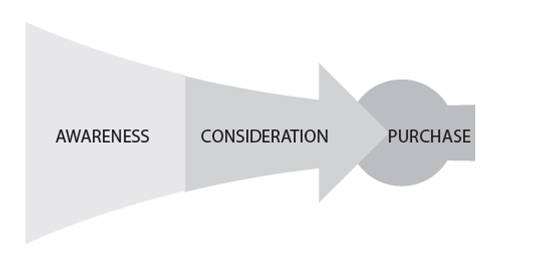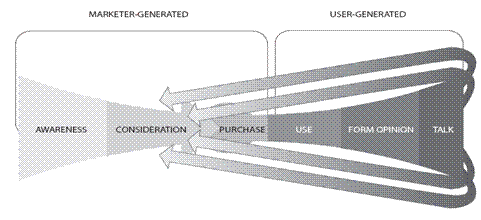You must have heard of AIDA — it is a basic principle that everyone should be using to communicate with their audience. It is a very powerful way to lead your prospect through the sales process to a buying decision.
However, even greater success comes from being an exceptional communicator. Most business owners can apply AIDA fairly effectively when they know how but what is it that makes the difference between mediocre or merely functional to being a runaway success?
It’s all about being a skilful communicator and we can learn a great deal from the great leaders of the past and present — you don’t become a great leader without being an amazingly effective communicator. I am about to share some of the communication secrets of the great leaders and will take you beyond AIDA in your quest to double your profits but first let’s take a look at the basics.
What is the AIDA Principle?
The AIDA Principle
To make your marketing more effective, you should remember AIDA and apply it to everything you do. Use it as a checklist when you are creating your marketing campaigns and you will see an improvement in your leads and your sales conversions.
So what does AIDA stand for?
• Attention
• Interest
• Desire
• Action
Attention
The first thing you have to do is get your prospect’s attention, whether they are visiting your website, looking at your poster or leaflet or thumbing through your brochure, you have to literally grab their attention and compel them to read more.
The best way to do this is with powerful headlines and subheadings. They should give an indication of what the section is about rather than some vague obscure words that don’t mean very much. Use your best keywords in your headlines as long as they make sense. Headlines should pull your reader in to want to read the section of copy that follows.
You can also grab people’s attention with a picture or illustration. Often this is the first thing or even the only thing they will look at as they skim over your material or website. Make sure pictures are relevant and they tell a story. Ideally, pictures should show your products and services in action and create excitement about what you have on offer. For example, your garden centre could show pictures of beautiful flowers or the plump vegetables you will get from a packet of seeds, your wrinkle cream should show the before and after pictures and the benefits of using your product. Make your pictures and illustrations work hard for you.
On your website, you can use all manner of interactive media to grab your visitor’s attention – video and audio, for example, are excellent ways to pull your visitors into your site.
Interest
Once you get someone’s attention, you have to keep them interested so you can tell them about the benefits of your products or services. Make it easy for them to understand what it is you are offering by using bullet points and lists of the benefits they will get. Show the benefits in action with pictures, illustrations and videos.
Use interesting snippets of information and find ways to intrigue your readers so that they continue to read on or stay on your site. If you are communicating your marketing message with printed media or via TV or radio, for example, try to entice them onto your website where they can complete a purchase or find out more. At the very least, you want to collect their contact details so you can make future offers and start building that all important customer relationship.
Desire
Having an interest in your products and services is not enough. You have to create a strong desire – even a craving for what you have to offer. Show other people enjoying the benefits of your products and services and use positive testimonials to persuade your visitors or readers that others love what you have for them and they will too.
Reiterate the benefits and really play on the emotional reaction of your audience. For example, that wrinkle cream you’re offering – try to show your prospect how having fewer wrinkles will enhance their life, their desirability and their confidence. Tell a story about how your wrinkle cream will boost their self-esteem and improve their life. It’s not really about the product – it’s all about the desire for a better life, more happiness, more charisma, eternal youth and more of the good things in life. Can a humble jar of wrinkle cream do this? You bet it can if it’s marketed in the right way. Think of the billions of dollars spent on creams and cosmetics every year – all these people are buying into a lot more than just a jar of cream…
This line of thinking goes for any product or service you are offering – just pull out all the benefits and make it emotionally appealing and valuable for your prospects and you are on the right track…
Action
Now you have them craving for your products or services, you have to get them to act on this desire. You need a strong call to action.
Desire or craving is not enough – you have to get them to take action and actually get their cash or plastic out of their wallet and buy what you have on offer. You need to make this very simple and easy and you have to tell them exactly what it is you want them to do next. Do you want them to click onto the ‘buy now’ button? Then tell them ‘Buy my product – click on the buy now button’. Don’t be shy. You’ve done all the work of getting them this far – don’t let them get away now. Forget namby-pamby, wishy-washy pussyfooting around – just ask them to buy your product!
Beyond AIDA
Okay, now you have the basics of AIDA, you can apply this principle to all your communication with your prospects and customers. This alone will significantly increase your sales conversion and I highly recommend you apply these principles immediately to all your marketing materials.
However, if you want to enjoy truly great success and develop longevity in your business, you need to go beyond AIDA. You need to develop some of the exceptional communication skills of the great leaders. I am not talking about the way you’d use words or how vast your vocabulary is or even your careful attention to grammar and syntax. I am not talking about how much you talk to people. I am talking about the sort of communication that cannot be taught in school — I’m talking about the rare communication traits of great leaders.
Great communicators have a rare ability to be aware of things outside of themselves. Even when they talk about their own thoughts and ideas, they do so in a way that speaks of your dreams, aspirations and emotions. Their message reaches the hearts of their audience in a way that ordinary sales copy, marketing or other communication cannot reach.
They have a heightened sense of awareness which makes them effective observers, great listeners and proficient at sensing moods, dynamics, attitudes and the values and worries of their audience. It’s very much like a sixth sense that allows great communicators to detect the needs and expectations of their audience — then deliver exactly what they need right on time.
So, what are the secrets of the great communicators? Apply the following principles in your communication with your prospects — and everyone involved with your business — and I promise you will vastly increase your success.
Speak the truth
People sense when they are being lied to, whether it is in person, over the phone or through the written word such as your marketing material. They may not be able to put a finger on precisely what’s wrong but there is always a sense of something that is not quite right.
This completely destroys trust. People won’t be inclined to engage with you, keep reading or develop any desire for your offer — let alone buy anything — if they don’t feel they can trust you. If there is an element of doubt – most people will decide not to bother, after all there are plenty of other businesses out there to choose from. People are willing to take more risks and invest more time if they trust you. They will also forgive mistakes and misjudgements if they trust you, so it is always worth being honest.
Too many business owners demand trust from their customers, yet attempt to deceive them into buying their products and services by being less than truthful with their sales copy. This rarely works and can backfire badly, especially when bad news travels so much faster in the digital age of the Internet.
So, always be truthful with your audience and build genuine trust as this is the best way to build a successful, long-term business where you cultivate a list of loyal customers. You already know that it’s easier to sell more to your existing customers than it is to constantly chase new business, so this should make good business sense…
Make it personal
Great leaders and great communicators develop meaningful relationships with people by addressing them on a personal level. The old axiom that: ‘people don’t care how much you know until they know how much you care’ is absolutely true. People not only need the truth before they will trust you, they also need to know that you care about them and actually want to help them with your products and services.
With face-to-face selling, it is easier to get across your genuine desire to help people. You can look people in the eye and show your sincerity. With written marketing materials such as your website, leaflets, brochures and adverts, it is not so easy. However if you write your materials on a personal level — as if you’re writing to a friend — you will communicate on a far deeper level than most businesses ever manage to achieve.
Great communicators are able to speak to large groups of people yet still achieve an intimate and personal atmosphere — they manage to speak directly to each person as an individual. This helps significantly in establishing rapport, trust and credibility.
A good way to make your communication more personal via the Internet is to use videos of you talking to your audience and photos of yourself so that people can see who you are. You can also invite your audience to listen to webinars and so on if you are unable to meet them in person.
The main message is to genuinely care about the needs of your customers and address them personally, as if your whole business exists just for them.
Practice empathy
Caring about your customers can be taken a step further by communicating with empathy. Too many business owners let their ego and pride get in the way of genuine communication with their customers — often they are operating from behind a façade. This can be due to an overinflated ego, arrogance or simply following the herd when it comes to selling and not understanding the need for genuine, open communication.
Communicating with empathy means genuinely connecting with your audience and really understanding life from their perspective – you can greatly increase your success by understanding how your customers feel by putting yourself on their side of the fence.
Listen effectively
Great communicators know when to stop talking and start listening. Truly effective marketing is not about assaulting your prospects with an incessant monologue — it is about a meaningful conversation that shows you are listening.
Social media is a good platform for this sort of communication, but don’t limit your listening skills to one form of communication. Use your primary market research and really listen to what your customers want — when you do this you will finally understand what is needed to create a perfect product or service.
Tune in to your audience
Great communicators not only know when to shut up and listen – they are able to tune in to their audience intuitively and read between the lines. People communicate what they want not just by what they say, but by what they don’t say.
Again, by doing a thorough job of your market research, you can tune into your audience more effectively. This is why it is so important to know your market and why I have been laboring the point. Get plenty of details, but also take time to step back and get an overview of what the market is saying to you. Learn to tune in with your intuition and understand what your market is looking for so you can provide the solution.
Be open-minded
Too many people believe they have an open mind, when in fact, it is simply vacant! Plenty of businesses fail because their owners limit their opportunities because they have a rigidly closed mind. Great leaders and great communicators are willing to listen to other people’s opinions and ideas with an open mind and a spirit of cooperation.
Just because you listen to others, it doesn’t mean you’ll be forced to change things — but it is important to have an open dialogue with people who challenge you or confront you. There is always another point of view to consider.
Also, be willing to learn from your competitors with an open mind. Perhaps there is something they are doing successfully that you could adapt to your business? The point is to be willing to be open-minded to what others have to say and to approach opportunities without a limiting and rigid mind-set.
Be prepared to unlearn what you know
This is related to having an open mind but goes a huge step further. If your beliefs and assumptions are challenged, you should be open minded enough to listen but if you believe a new paradigm might be beneficial to you or your business, you should be prepared to unlearn what you know and start with a clean slate.
Be concise
I mentioned being concise when you implement the AIDA Principle, and it applies to all your communication with your customers and prospects. People seem to have less time than ever today to listen to or read long drawn-out sales pitches that take forever to get to the point.
Great communicators get their message across clearly, simply and concisely. Don’t forget that your message can be drowned out with a lot of fluff and flannel and it can be confusing for your readers to have to plough through pages of irritating sales talk. If you want to communicate effectively with your prospects it is vital that you learn to cut to the chase and communicate the highlights succinctly.
Don’t lose your readers before they get to the good bits. People will tune out way before you get there if your message is full of superfluous and unnecessary material. Re-read last month’s profit-making principle — pitch anything in 15 seconds or less. This is how concise you need to be if you want to communicate effectively.
Contribute more than you get back
It’s about going the extra mile for your customers and being willing to serve them. You will receive far more than you give when you genuinely focus on what your customers want and desire rather than always thinking about your own agenda.
Many companies that get their business primarily from referrals embrace this principle wholeheartedly. They give more to their customers and are willing to make that extra effort for them and they are rewarded with a stream of new business. Recommendation is the very best way to build your business. It’s also free!
Know what you’re talking about
People can see right through you if you waffle, clearly not in command of your subject. These days there is greater emphasis on having expertise in your field and if you don’t possess this your competitors undoubtedly will.
People are short of patience if you can’t add value to a topic or add something new. The Internet is full of good quality information so you simply have to show that you know what you’re talking about. You might have been told it’s not what you say but the way you say it that counts – well that doesn’t cut it in business anymore. It does actually matter what you say and smooth talking salespeople (or sales copy) that lack substance and authority doesn’t make for a successful business, especially if you want your customers to come back again and recommend others. That’s the basis of a great business.
Follow up
Good communicators don’t assume that their prospect is ready to have a conversation with them just because they are ready. You have to follow up your communication over a period of time until your prospects is ready to talk to you or to take further action. Sometimes this can take years!
I told you a while back that the follow up is an important part of making a sale. Studies have shown consistently that it takes at least 7 positive contacts with your prospect before they are ready to buy. I would go further than that and say it can take a lot longer, so don’t give up trying to communicate with your prospective customers. Show persistence.
Keep following up until they tell you to go away! Unless they unsubscribe from your list or tell you in no uncertain terms that they are not interested in you, your business or what you have to offer, you can assume they are still interested to some degree.
Another reason to follow up regularly is that you can’t assume that your prospects really understand what it is you’re offering. Unless you are crystal clear and make it absolutely plain what it is you have to offer, it could take several attempts to get your message across. Try communicating your message from different angles and highlight different benefits because your audience will have diverse needs and desires — even for exactly the same product or service.
Let’s take an example I have used before. Imagine you are running a garden centre and you are trying to sell products related to growing vegetables in the garden — packets of seeds, plants and garden tools. One customer might want to buy your products because they love gardening and get a lot of satisfaction from being outdoors and connecting with nature. You might appeal to this customer with a headline like:
‘Get a taste of nature — grow your own organic vegetables.’
However, another prospective customer might be looking at growing vegetables from a different perspective. Perhaps they can’t afford to buy lots of fresh vegetables in the store and they are trying to grow their own simply to save money, even though they are not keen on gardening. You could appeal to this type of customer with a headline such as:
‘Grow your own delicious vegetables from just $2 – it’s simple with our easy-to-grow plant varieties ’
Keep finding effective ways to communicate with your customers and don’t give up before they do!
So, the message is that principles like AIDA work extremely well to lead your prospects through the sales process, but when you pay additional attention to genuine communication that is truthful, specific and clear you will be many times more effective at building a successful long-term business. Spend the extra time and effort on how you communicate with your audience and remember that it’s not about you, your opinions or your needs — it’s about meeting the needs of your customers, understanding their concerns and adding value to their lives.
 About David Anderson
About David AndersonMy name is David Anderson, owner of David Anderson Wealth. I am business guru with over 30 years of experience in small, medium and large (corporate) business. My goal is to teach anyone who wants to learn, how to make money online, improve a current business or develop a strong start up business online, from home or brick and mortar.
출처: http://www.davidandersonwealth.com/online-marketing-strategies/beyond-the-aida-marketing-principle/

